Eerste Plantiac Bedevaart
19 juni 1991
Deze pagina is (en wordt waarschijnlijk) niet in het Nederlands vertaald.
Before reading on, it is perhaps useful to know two things. First, this was written in a time when I knew next to no facts about the world of Plantiac and Plantinga. Second, the time in which it was written contained a much younger, more naïve and certainly less refined version of myself.
The time: 12 AM. The date: June 19th 1991. The location: Utrecht, The Netherlands. The people: The ST NEWS editorial staff. The weather: Lousy. The gear: A walkman, two cameras, some audio cassettes and a note on which is explained how to reach the Plantinga Distillery in Bolsward. And a car.
How it Started off
Everything started about three weeks earlier, when I found out that my then boss was the proud owner of all the Dutch phone books, stacked on one of the many shelves in his office.
Before the ST NEWS International Christmas Coding Convention (December 1990) happened, we had already tried to contact the Plantinga Distillery - which was mentioned on each bottle of Plantiac Vieux to be in Bolsward. We wanted to get our hands on huge quantities of the Divine Fluid, possibly including some merchandise.
Unfortunately, the Plantinga Distillery did not seem to exist according to the telephone number inquiry service. Strange but true. So we had to do without It at the Convention.
So when I discovered all these phone books I went to look for someone named Plantinga, anyone named Plantinga, in the phone book part covering this town in the Northern part of Holland by the name of Bolsward.
There was one Plantinga, and it wasn't the Distillery so it seemed. But I wrote a long letter anyway, explaining everything about ST NEWS, the Atari ST, our worshipping of the Divine Fluid and several other such things. This letter was very difficult to write, as the person in question might be man or woman, ancient or juvenile. Worse, of course, he/she might be sane.
Just like I expected a True Plantinga Heir to do, however, the letter eventually got forwarded to the proper people who answered me quite promptly.
As it turned out, a fusion with another large distillery by the name of Sonnema had caused the actual company to be called Sonnema-Plantinga Distillery - hence the problem with finding it through the telephone inquiry system (where the employees would certainly not tell one that such a name happens to exist, not even if they knew it).
The letter contained an invitation to come and visit the Distillery, together with some information pertaining the stuff that they make there. It clearly seemed that Plantiac Vieux was but a relatively minor product there, as they barely mentioned it. What they did mention, however, was that Sonnema Beerenburg and Plantinga Beerenburg were made there. These were obviously their major products.
So I contacted a PR person by the name of Mr van Zee. He told me it would be no problem at all to visit during any of the tours that they had. They had three tours a day - at 10 AM, 1:30 PM and 3PM. We were welcome to come any day we wanted, as long as we did it before the end of August.
So we made an appointment for 3 AM on June 19th, 1991. Stefan and me both had a day off then.
Just perfect.
I had Mr van Zee explain to me how to get at the actual Distillery, as neither of us had ever been way up in the Northern part of Holland (a province called Friesland). I scribbled the directions down on a note.
The Pilgrimage Starts
That was the note I held in my hands as we left my humble abode for the Pilgrimage to the Plantiac Distillery. It would have been even more perfect had it been a happy day with the sun shining and all, but unfortunately some God had considered it necessary to make this a particularly dreary day with lots of showers and a total lack of sunny intervals.
Although the tires of Stefan's car were well worn, we decided to do it anyway - nothing would keep us from this Quest, this Utterly Holy Crusade For The Divine Fluid!
So we left at about noon on that fateful day; the Day that was to enter history as the Day of the First Plantiac Crusade.
Apart from some heavy showers, where reduced visibility forced our master editor to slow down a bit, we crossed Holland at about 135 km/hour. We had no desire to admire the landscape, because we felt we should avoid arriving too late at all costs - one simply does not arrive too late on a meeting with people that have to do with the Divine Fluid.
On the way to Bolsward, we went through Flevoland (which is Holland's 12th and most recently assigned province, solely made of polders) and the Noordoostpolder (North-East-Polder), until at last we entered Friesland. Thankfully there was no Elfstedentocht.
Friesland
It was about 1 PM when we crossed the border to Holland's most unique province (maybe except for Limburg, which actually has hills that are not composed of household garbage). We felt a peculiar feeling draw upon us: A feeling of Purpose.
In this country, ancient with tradition, the Divine Fluid was born. We felt a deep and sincere gratitude and admiration towards the very soil that sped past us under the tires of Stefan's car.
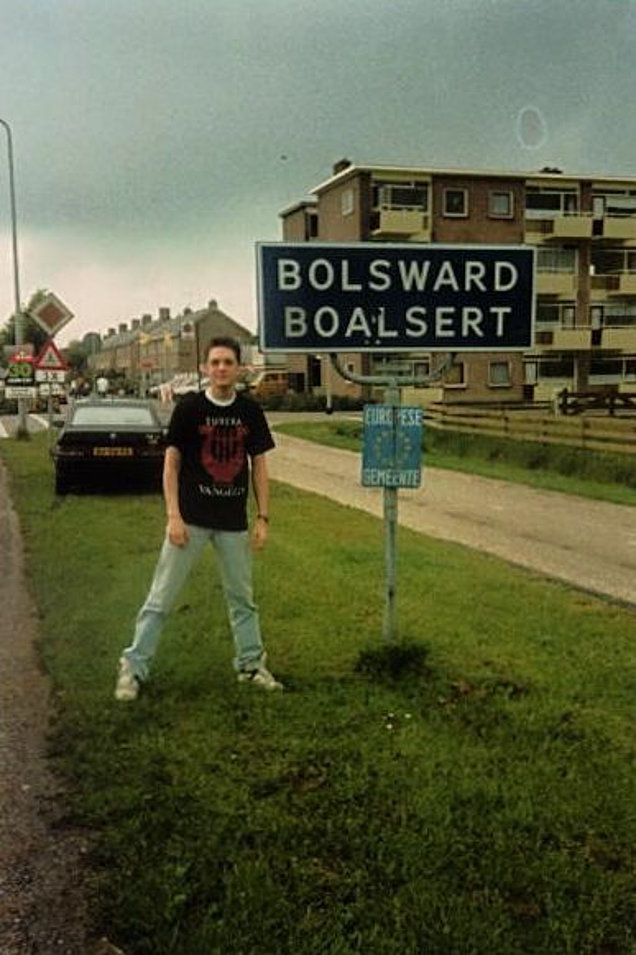
We arrived in Bolsward (which is called 'Boalsert' in Frisian) at around a quarter to two. There was still time aplenty for us to have a go at finding out peculiar things about local customs and, more importantly, to grab a bite to eat as we hadn't even bothered to break our fast.
We had expected a distinctly different culture, but were pleasantly surprised at the striking similarities with the culture of the rest of the Netherlands. Apart from the fact that all the names of people seem to end with '-ma' or '-inga', everything was actually pretty identical.
OK, there were a couple of old men wearing wooden shoes that cycled past us on pre-WW-II bikes, but that was about it.
We briefly visited a shop where they sold replicas of the coat of arms of ancient Frisian families. Unfortunately, we couldn't locate that of Plantinga. What a shame. We would have liked a banner or so with his family weapon on it.
So we decided to have a go at probing Frisian Fries Special instead.
When you're hungry everything tastes OK, and Stefan is a cultural barbarian who rarely doesn't eat microwave food so I considered his opinion on the curry sauce ("tastes OK to me") to be dismissable.
After our internals had been strengthened by this mass of fat accompanied with some Coke, we were fit enough to venture into the town itself.
Bolsward is quite a dull town, though it may be lethally exciting to people from Klaxos 9. Not much is going on and the shop centre is about 500 feet in length. The main tourist attractions seem to be a picturesque building along a bit of water, a rather derelict completely roofless church and a rather idyllic little brook with some fresh green trees next to it known as "The Green".
After we had tried Frisian junkfood, we strolled a bit through town until we had seen all these sights. Especially the derelict church was fascinating. It looked like a complete and utter ruin, but some historic pictures and stuff were located on the walls, and four speakers supplied the place with moody Gregorian singing.
That was rather strange, and at once we felt as if we were back in the middle ages - even before the time of Plantiac.
When we realised we were walking over the graves of 14th century monks we decided we'd better leave that place. Coincidentally, it had started to rain a bit.
The clock now signalled us that it was about time to go and find the Plantinga - excuse me - Sonnema-Plantinga Distillery. It was half past two.
The Sonnema-Plantinga Distillery
It was actually a branch off the 500 metre long shopping precinct annex main road, and could therefore be found very easily.
Unfortunately, we didn't know this fact. So we had to resort to asking someone at a local gas station to explain how to get there. A slightly shabby and flop-bellied female eyed me suspiciously while she answered me, completely failing to hide from me the fact that in her eyes I was but a mere barbarian from beyond Friesland's boundaries.
So we entered that same main road again, but this time from the other side. While we were fighting down a wild fit of déjà vu that nearly rendered Stefan unconscious, we drove into that branch, the Turfkade, that after some hundred metres changed its name to Stoombootkade (which means 'Steamboat Embankment').
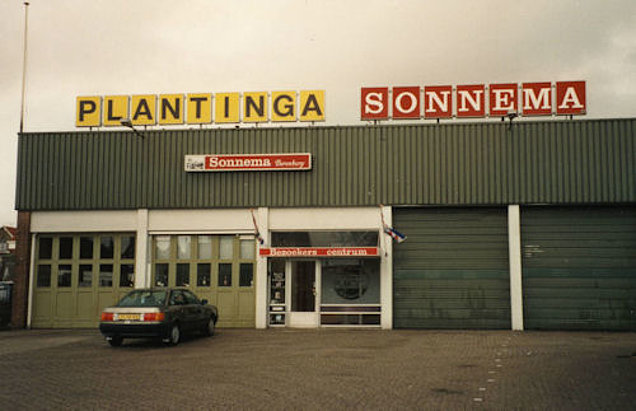
That was the place. The place where the Divine Fluid was supposed to have been born, brewed and bottled since 1870. We felt powerful feelings of emotions slither through our veins as we conquered the last bend in the road, revealing to us a sign that pointed at the parking lot of the Sonnema-Plantinga Distillery.
We jumped out of the car after having parked it quickly. We hummed ancient chants, knelt down and prayed as we kissed the ground solemnly. This was Holy Soil we were treading now, and we felt it radiate with an ancient kind of eerie power, that seemed to envelop our bodies and penetrate our beings much in the way half a litre of Plantiac Vieux would. Only this time we didn't stagger. Instead, we purposefully strode towards the front door.
A woman had already seen us taking pictures of the One Distillery, this Sacred Spot, and had come outside with the mundane question whether she could perhaps be of some assistance.
We gasped as we, nonworthy humans that are in no way connected with the production of the Divine Fluid, were addressed by a woman who apparently was a Disciple of the Fluid. We could barely find the decency to nod affirmatively, after which she lead us up a winding staircase into the visitor's centre of the One Distillery.
The Visitors' Centre
At the end of the stairs was a small hall, that lead into a room where Ancient Relics were displayed. However, these relics were primarily pertaining Sonnema Berenburg and thus not of much interest to us Sonnema-infidels. Only a couple of pictures seemed to display something with regard to Plantinga, and none indicated even the existence of what we considered to be the best drink anywhere in the place we call 'world'.
Obviously, it wasn't a major product here. Everything was very much narrowed down to Sonnema Berenburg.
Two doors opened to the display room, and when we left through the other we entered the actual visitor's centre, which was a reproduction of a typical old Frisian pub primarily painted brown and red. The bar was located in front of another door, which lead into the kitchen. In the far wall was another door, that would turn out to lead to the production room.
This visitor's centre had been opened up in June of 1988, and since then there had been 25,000 visitors (gasp!).
As we looked around slightly uncomfortably we got offered coffee (which we both don't like so we got tea instead) and sat down. Feelings of Divine Reverence had transmutated into feelings of uncertainty. Apart from one bottle of Plantiac we had not seen any evidence that the Divine Fluid was made here at all.
Our stomachs knotted in uncertainty.
Well, no matter what happened, at least we could get maybe a box full of Plantiac at a reduced price, a load of little 40 cc bottles that we had seen on display, and maybe some Plantinga/Plantiac merchandise like little glasses and such.
I inquired.
The shock to me could not have been less than the one Caesar got when he felt Brutus' knife penetrate his chest (or was it his back?). Dazed and confused, I staggered back to the table that held our tea. With trembling hands I tried to sip some of it, but couldn't.
They did not have a full license and were thus not allowed to sell any of the goods, except for demonstration packages that only existed for Sonnema Berenburg and Plantinga Berry Liquor. The little bottles of Plantiac we saw on display next to the door to the production floor turned out to be very old and they doubted whether they were actually still made. There were no little glasses with 'Plantiac' written on them, either.
The disappointment was immense.
I felt much of the enthusiasm leave me, and I am certain Stefan felt much the same way. But, tough luck or not, we would at least get to see the location where Plantiac Vieux was made. We would get to make photographs of ourselves standing next to an enormous kettle (or whatever) of the stuff. A part of our Purpose was intact.
The Tour
About half an hour late due to the fact that a group of people refused to appear and only then called to say they wouldn't come at all, the presentation started. Mr van Zee, an authority in the field but not the most enchanting of narrators, spoke to us of the history of Sonnema and Plantinga Be(e)renburg, the history of the One Distillery (which he just called 'the distillery') and more such. We got a slideshow presentation that looked OK, with good background music and narration. According to something akin to legend, everything started in the Northernmost town of Holland, Dockum (also in Friesland). The year was 1860. There lived a chap called Fedde Sonnema, who was a landlord. Instead of selling his clientele pure gin he sold them gin that had been soaking through herbs that he used to pick himself in the Frisian landscape. This was a very common thing for landlords to do, but our friend Fedde just did it a tad differently so that more and more people wanted to drink that stuff.
He had to take things on differently. He arranged a chap called Beerenburg from Amsterdam who was a herb specialist and Fedde called his drink Sonnema Berenburg (with one 'e' missing because he was a stiff-necked Frisian and wanted it that way). He used 71 herbs, by the way (the combination of which is top secret). Eventually, it became a true distillery - the Sonnema distillery.
When Dockum became too small, the company that Fedde had built up wanted to work together with someone who had a bigger distillery and more space, and that's when the Plantinga Distillery came into the picture, in 1967 (which is the year of my birth, coincidentally).
Plantinga was at the time reknowned for its Vieux and its own Plantinga Beerenburg.
When the slideshow presentation ended, the lights were turned up again and Mr van Zee lead us through that mysterious door in the far wall. We gazed at the 40 cc bottles in the display near the door with a kind of distant longing, filled with immeasurable sadness (not the bottles, but the two of us).
The sound of many bottles moving on a conveyor belt came towards us. The most remarkable fact was that it did not smell like any kind of alcoholic liquid there. Whereas we had expected a smell like a zillion drunkards' breath, this was not the case.
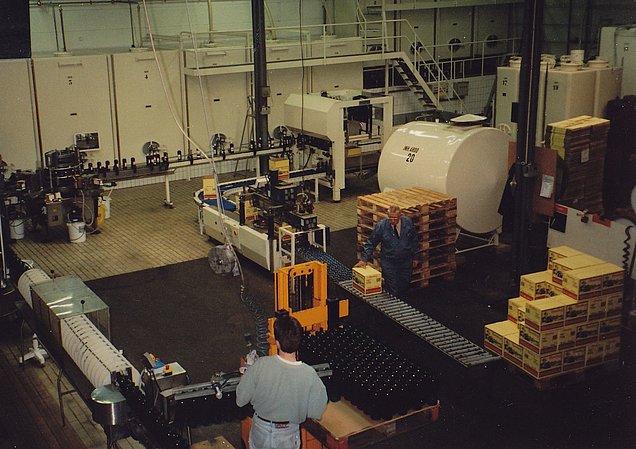
We were standing in an open hallway with quite a large production floor annex storage room to one of its sides, where people were producing Sonnema Berenburg. No Plantiac to be seen so far, but we guessed that maybe this drink wasn't as popular as Sonnema so that the tour would not include it. At one of the far walls there were huge metal tanks where thousands of litres were soaking with herbs (10,000 litres, to be more precise). Against the other far wall, opposite the open hallway, were located some tremendously huge wooden barrels where the Plantinga Beerenburg was soaking with herbs.
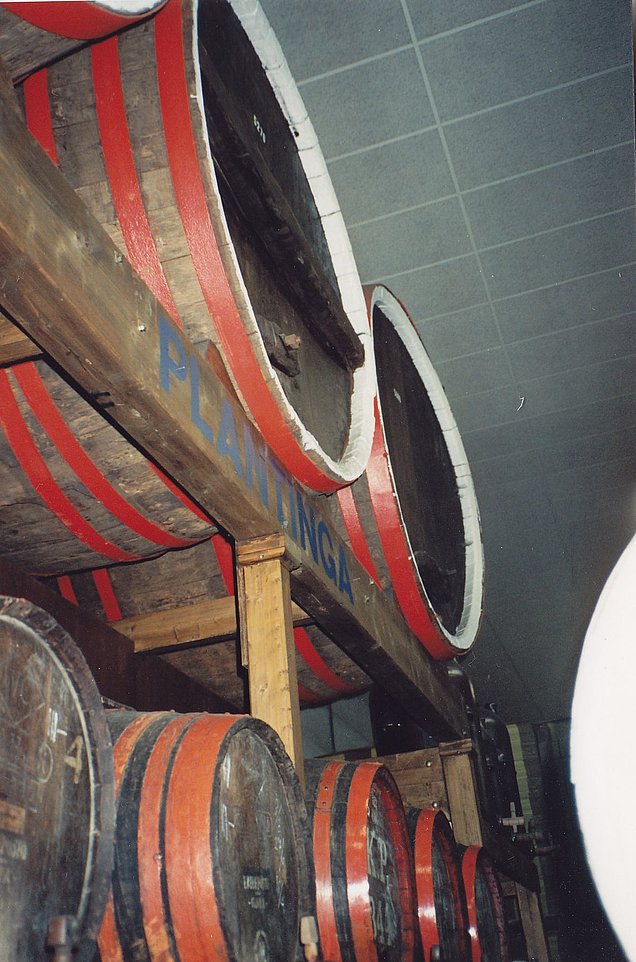
Sonnema Berenburg takes 24 hours to soak, and herbs are added every day. Plantinga Beerenburg takes three times 12 days to soak, and between each soaking the old herbs are completely removed and fresh ones added.
Mr van Zee told us that the taste was vastly different, and that people should preferably take small sips of the Plantinga stuff should they decide to taste it after this tour.
Stefan and me were certain: We simply felt in our guts that we had discovered what may very well turn out to be the Divine Fluid II - Plantinga Beerenburg.
After we had looked at the conveyor belt enough (bottles put on belt, bottles being cleaned with air, bottles being filled, labels being put on the bottles, bottles being put in cartons that were assembled in real time), and after I had made a picture of a solemn-looking man with reading glasses who was in charge of the quality control, we went back to the visitor centre to have a go at tasting this stuff.
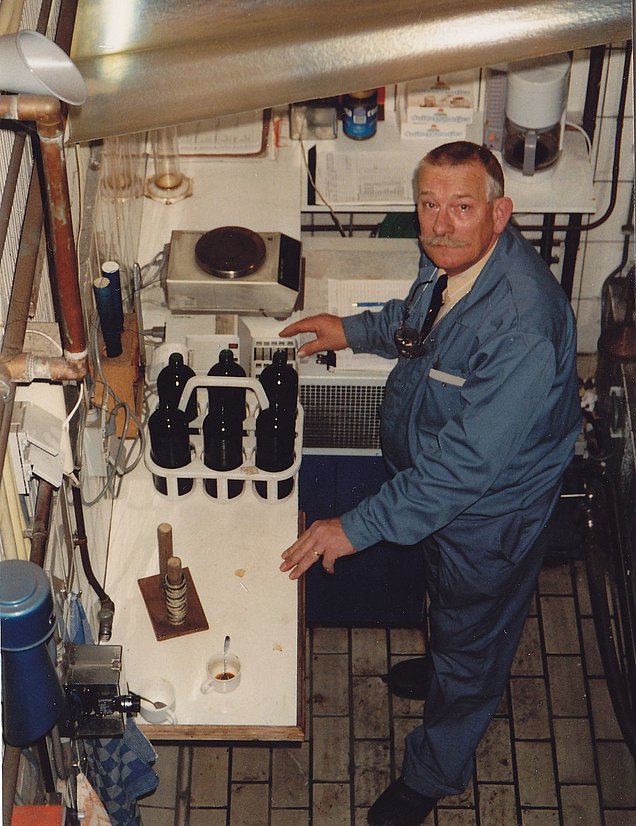
The Tasting
Surely, Plantinga Beerenburg would be the perfect drink to adopt as the new standard. It was told to be very spicy, it was fully natural, and still made in a very traditional way!
Mr van Zee asked me if I was the guy that had phoned him earlier with regard to Plantinga. I nodded emphatically.
"OK," he said, "we'll go down after the others have gone to have a more in-depth look there."
In my eyes I saw visions of another working floor where the Divine Fluid was made. I blinked away the monks that mysteriously penetrated those visions. My enthusiasm, which had ebbed away as I came more and more convinced that Plantiac actually didn't exist here in Bolsward at all, was slowly returning.
So with new vigour I went forward, trying not to point at a bottle of Plantinga Beerenburg too frantically when the lady behind the bar asked me which drink I would like to taste. She poured it in a glass. Stefan took another glass and held it ready for her to pour some in that as well. A strange gleam was in his eyes.
The Divine Fluid II. Plantinga Beerenburg.
It had everything it needed. Heritage. Tradition. The way of Preparation.
I took a sip, and so did Stefan.
Have you ever tasted a mixture of chewing tobacco and ground wood? Well, that's approximately the taste of Plantinga Beerenburg. Stefan pulled an awkward face, and promptly told the lady 'he still had to drive', putting down the glass.
I wasn't yet too sure about the taste. Maybe I shouldn't take those tiny sips, so I emptied the rest of the glass in one swig. I had anticipated my throat to get burned, or at least my stomach to get very warm, but neither happened. And it still tasted like chewing tobacco mixed with ground wood (i.e. like complete and utter shit in a liquid form).
We quickly revised our nomination of a new Divine Fluid. There will forever be none, I think, as Plantiac is simply the best.
We also tasted Sonnema Berenburg (which doesn't taste too good, but which is suddenly heaven on earth if you've done the tobacco'n'wood thing before), Plantinga Berry Liquor (which is OK) and some juice to wash it all away.
By that time, our greedy eyes full upon something we wanted to acquire. You ever seen people in a pub pour strong drinks straight from the bottle? Bet you haven't. They use a thingy to put on top of the bottle that allows a thin 'beam' of fluid to appear from it when held upside down.
We now both gazed greedily upon a metal one of those that had the word "Plantiac" attached to it. We asked the lady behind the bar but she told me they weren't for sale.
Darn! Hellfire and mutant zombies!
Now everybody was slowly leaving the place, and Mr van Zee came to us. Now, we could go down onto the production floor, where we could make pictures in detail of those huge Plantinga barrels. When we carefully, hesitatingly, told him that this was all very nice but we now really wanted to see the place where Plantiac Vieux was made, he looked genuinely surprised.
"Don't you know? Did nobody tell you?" he asked, "It's made in Schiedam..."
Now it was our turn to be surprised, carefully trying to hide the ultimate disappointment that had now struck our eager souls. It was like looking at naked girls dancing in Moulin Rouge, to discover that it was in Lourdes that Maria was sighted and not in a nightclub. Or like seeing the Virgin Mary appear when you're expecting topless girls.
Mr van Zee sensed it, and sought ways to consolidate us.
Well, after all we had seen the place were Plantiac was born, right? Yes, we were right there. It was indeed Bolsward where it was born.
Lucky enough, Stefan and myself did know how we could be consolidated: After the poor man gave us a phone number in Schiedam to call, we looked around to see if the lady had gone and then asked him whether that metal 'drink pouring cap' (or whatever it may be called) we had discovered on those bottles were for sale.
He didn't think long and gave it to us. He even found a second one so Stefan and me didn't have to slaughter each other.
Deeply grateful for the acquisition of these items ("Well," Mr van Zee said "I guess those were the last two!" after which he replaced them by cheap plastic ones that he had hundreds of), we spoke our farewell and headed back to town to see if the local licensed victualler might perhaps sell Plantiac at a reduced price (or perhaps in those cute little 40 cc bottles).
Nope. It was priced much like everywhere else in Holland. It only succeeded in us getting slightly soaked as we got hit by quite a heavy shower on our way back to the car.
The entire day we had succeeded in surviving heavy showers in a very dry fashion, but we could have guessed that God would have his way eventually with us heathens.
The End of Part I
And thus endeth part I of the Pilgrimage, that had turned out to become a regular Quest after all. At least now we knew where It was really made, so we knew the destination of our Second Plantiac Pilgrimage - Schiedam!
We left Bolsward at about 5 PM. We stopped at a fuel station to get some gas and Coke, pumped up the volume of one of Stefan's 'Metal Mania' tapes and drove home.
As both Stefan and myself had never been at the Afsluitdijk before, we decided to go that way now, and drive through the province of North Holland instead of Flevoland (i.e. the other way around).
At a quarter to seven we were in Utrecht again.